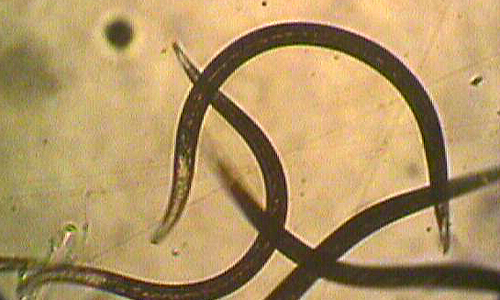Diaprepes root weevil
Damage caused by Diaprepes root weevil
Diaprepes root weevil, Diaprepes abbreviates is one of the most economically important insect pests of citrus and many ornamental plants. Adult weevils mainly feed on the edges of leaves whereas larvae (grubs) feed on the roots. Feeding by adult weevils gives characteristic leaf notching appearance to leaves whereas feeding by grubs mainly causes pruning of the roots of their hosts. In case of severe girdling of main root by grubs can results into the death of citrus trees.
Facts (show all)
- Common names
-
- Diaprepes root weevil or Citrus root weevil
- Scientific name
-
- Diaprepes abbreviates
- Identification
-
Adults: Adults of diaprepes root weevil are black in color with black stripes on the front wings (elytra).
Eggs: Eggs of diaprepes root weevil are whitish-yellow, oval in shape and about 1.1mm long X 0.4-0.5 mm wide.
Larvae: The larvae (grubs) of diaprepes root weevil are legless, creamy white in color and with light brown head capsule.
Pupae: Pupae of diaprepes root weevil are reddish in color and oval shape.
- Biology
-
Diaprepes root weevils commonly lay eggs in a cluster of over 50 eggs inside the fold of two adjacent leaves that are glued together. Eggs hatch within a week into first stage larvae that immediately fall off the leaf on the ground and burrow in the soil. Once in the soil, these larvae begin feeding on the fibrous roots. While feeding, larvae complete about 10 to 11 instars (mature grub) within 12- 15 months and then pupate in the soil. New adult weevils will start emerging from pupae May through November in the soil. Generally adult weevils will emerge from soil when there is optimum moisture in the soil. Since adults do not fly, they generally climb on the tree trunks and walk towards the canopy where they feed on the leaves, mate and laying eggs in the clusters on the leaves. Depending upon the soil temperature and moisture, diaprepes root weevils complete their life cycle within 6 to 18 months.
- Organic Control of Diaprepes root weevils
-
- Following beneficial bugs and plant products can control Diaprepes root weevils organically
- Beneficial entomopathogenic nematodes
-
- Steinernema carpocapsae
- Heterorhabditis bacteriophora
- Heterorhabditis indica
- Neem Product
-
- Molt-X- Azadirachtin




